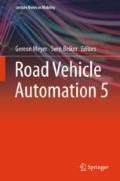Abstract
Modeling the impact of connected and automated vehicles (CAVs) on the environmental sustainability, mobility and safety of roadway traffic at the local link level or the regional network level requires a significant amount of currently non-available data. Multiple CAV test-beds and data collection efforts utilizing the latest sensing and communication technologies have been however publicized over the past few years. Such efforts have been led by the industry and public agencies in the US and abroad. Accordingly, (1) researchers and practitioners should be aware of the type and quantity of data needed to calibrate and validate traffic models while taking into account the impact of CAV technological specifications, the driver behavioral characteristics and the surrounding driving environments. (2) Moreover, the gap between such emerging data needs and the data made available to researchers or practitioners should be identified. This chapter summarizes the presentations of speakers that are investigating such gap during the Automated Vehicles Symposium 2017 (AVS17) held in San Francisco, California on July 11–13, 2017. These speakers participated in the break-out session titled “Enhancing the Validity of Traffic Flow Models with Emerging Data”. The corresponding discussion and recommendations are presented in terms of the lessons learned and the future research direction to be adopted. This session was organized by the AHB45(3) Subcommittee on Traffic Flow Modeling for Connected and Automated Vehicles.
Access this chapter
Tax calculation will be finalised at checkout
Purchases are for personal use only
Notes
- 1.
By Rita Excell, Australia and New Zealand Driverless Vehicle Initiative.
- 2.
By Jiaqi Ma, Leidos Inc.
- 3.
By Steven Shladover, PATH, UC Berkeley.
- 4.
By Daniel Work, University of Illinois at Urbana Champaign.
References
Calvert S, Mahmassani HS, Meier J-N, Varaiya P, Hamdar SH, Chen D, Li X, Talebpour A, Mattingly SP (2007) Traffic flow of connected and automated vehicles: challenges and opportunities. In: Roadway vehicle automation, 4 edn. Springer, pp 235–245
Regan M, Cunningham M, Dixit V, Horberry T, Bender A, Weeratunga K, Cratchley S, Dalwood L, Muzorewa D, Hassan A (2017) Preliminary findings from the first Australian national survey of public opinion about automated and driverless vehicles, p 24. http://advi.org.au/wp-content/uploads/2017/08/ADVI-Public-Opinion-Survey_Final_ISBN.pdf
Learn S, Ma J, Raboy K, Zhou F (2017) A freeway speed harmonization experiment using connected and automated vehicles. IET Intell Transp Syst. https://doi.org/10.1049/iet-its.2017.0149
Ma J, Zhou F, Huang Z, Melson CL, James R, Zhang X (2018) Hardware-in-the-loop testing of connected and automated vehicle applications: a use case for queue-aware signalized intersection approach and departure. Transp Res Rec J Transp Res Board 18 (in-press: paper number 18-05431)
Liu H, Xiao L, Kan X, Shladover S, Lu XY, Men M, Shakel W, van Arem B (2018) Using cooperative adaptive cruise control (CACC) to form high-performance vehicle streams. PATH Final Report, Feb 2018
Stern RE, Cui S, Delle Monache ML, Bhadani R, Bunting M, Churchill M, Hamilton N, Haulcy R, Pohlmann H, Wu F, Piccoli B, Seibold B, Sprinkle J, Work DB (2018) Dissipation of stop-and-go waves via control of autonomous vehicles: field experiments. Transp Res Part C Emerg Technol 89:205–221
Acknowledgements
The authors would like to acknowledge the breakout session organizers (the AHB45(3) committee members along with Robert Bertini from University of South Florida and Soyoung Ahn from University of Wisconsin, Madison) who made this book chapter possible. Special thanks to Xiaopen Li from the University of South Florida, Danjue Chen from the University of Massachusetts Lowell, Steven Skabardonis from the University of California at Berkeley, Haizhong Wang from Oregon State University and Mark Brackstone from TSS-AIMSUM for their outreach efforts while coordinating the event details with the AVS2017 organizing committee.
Author information
Authors and Affiliations
Corresponding author
Editor information
Editors and Affiliations
Rights and permissions
Copyright information
© 2019 Springer International Publishing AG, part of Springer Nature
About this paper
Cite this paper
Excell, R. et al. (2019). Enhancing the Validity of Traffic Flow Models with Emerging Data. In: Meyer, G., Beiker, S. (eds) Road Vehicle Automation 5. Lecture Notes in Mobility. Springer, Cham. https://doi.org/10.1007/978-3-319-94896-6_20
Download citation
DOI: https://doi.org/10.1007/978-3-319-94896-6_20
Published:
Publisher Name: Springer, Cham
Print ISBN: 978-3-319-94895-9
Online ISBN: 978-3-319-94896-6
eBook Packages: EngineeringEngineering (R0)

